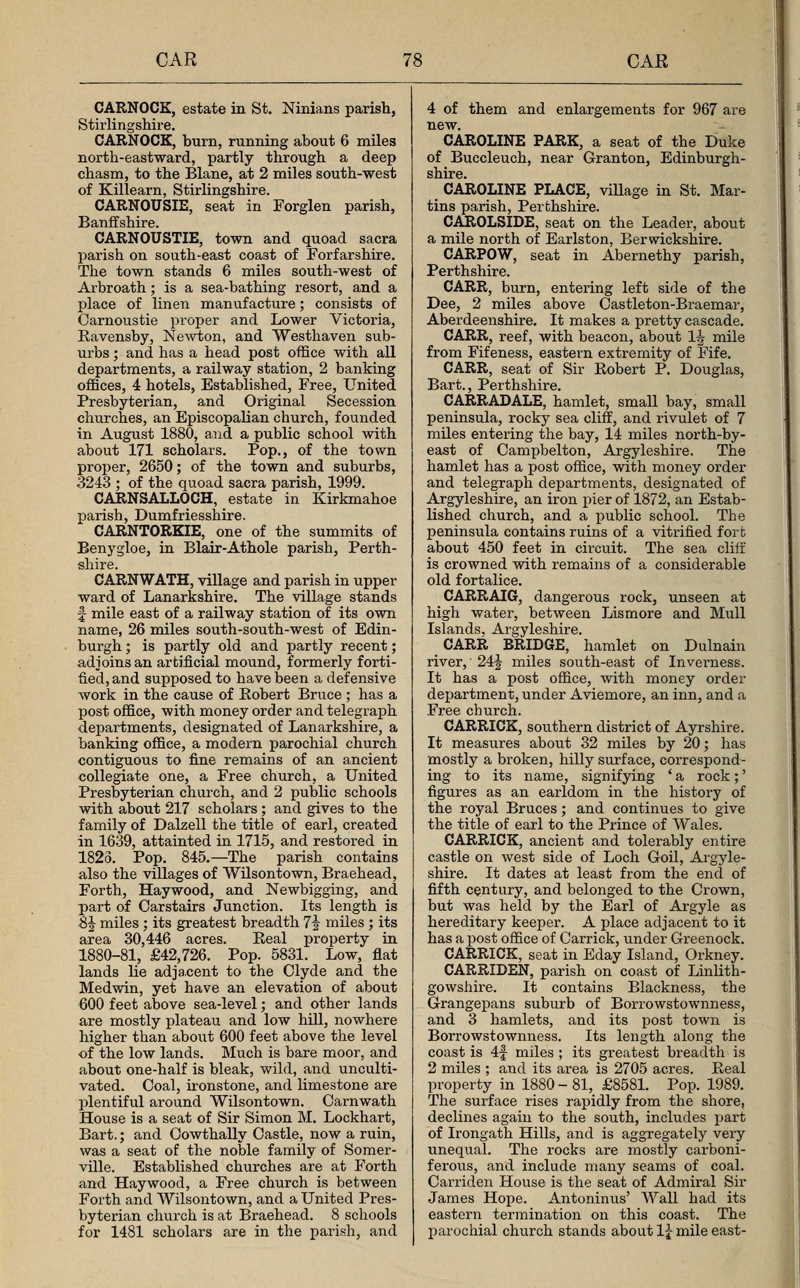CARNOCK, estate in St. Ninians parish, Stirlingshire.
CARNOCK, burn, running about 6 miles north-eastward, partly through a deep chasm, to the Blane, at 2 miles south-west of Killearn, Stirlingshire.
CARNOUSIE, seat in Forglen parish, Banffshire.
CARNOUSTIE, town and quoad sacra parish on south-east coast of Forfarshire. The town stands 6 miles south-west of Arbroath ; is a sea-bathing resort, and a Slace of linen manufacture ; consists of arnoustie proper and Lower Victoria, Ravensby, Newton, and Westhaven suburbs ; and has a head post office with all departments, a railway station, 2 banking offices, 4 hotels, Established, Free, United Presbyterian, and Original Secession churches, an Episcopalian church, founded in August 1880, and a public school with about 171 scholars. Pop., of the town proper, 2650; of the town and suburbs, 3243 ; of the quoad sacra parish, 1999.
CARNSALLOCH, estate in Kirkmahoe parish, Dumfriesshire.
CARNTORKIE, one of the summits of Benygloe, in Blair-Athole parish, Perthshire.
CARNWATH, village and parish in upper ward of Lanarkshire. The village stands mile east of a railway station of its own name, 26 miles south-south-west of Edinburgh; is partly old and partly recent; adjoins an artificial mound, formerly fortified, and supposed to have been a defensive work in the cause of Robert Bruce ; has a post office, with money order and telegraph departments, designated of Lanarkshire, a banking office, a modern parochial church contiguous to fine remains of an ancient collegiate one, a Free church, a United Presbyterian church, and 2 public schools with about 217 scholars ; and gives to the family of Dateell the title of earl, created in 1639, attainted in 1715, and restored in 1823. Pop. 845. The parish contains also the villages of Wilsontown, Braehead, Forth, Haywood, and Newbigging, and part of Carstairs Junction. Its length is S$ miles ; its greatest breadth 7J miles ; its area 30,446 acres. Real property in 1880-81, 42,726. Pop. 5831. Low, flat lands lie adjacent to the Clyde and the Medwin, yet have an elevation of about 600 feet above sea-level ; and other lands are mostly plateau and low hill, nowhere higher than about 600 feet above the level of the low lands. Much is bare moor, and about one-half is bleak, wild, and uncultivated. Coal, ironstone, and limestone are plentiful around Wilsontown. Carnwath House is a seat of Sir Simon M. Lockhart, Bart.; and Cowthally Castle, now a ruin, was a seat of the noble family of Somer-ville. Established churches are at Forth and Haywood, a Free church is between Forth and Wilsontown, and a United Presbyterian church is at Braehead. 8 schools for 1481 scholars are in the parish, and 4 of them and enlargements for 967 are new.
CAROLINE PARK, a seat of the Duke of Buccleuch, near Granton, Edinburghshire.
CAROLINE PLACE, village in St. Mar-tins parish, Perthshire. CAROL8IDE, seat on the Leader, about a mile north of Earlston, Berwickshire.
CARPOW, seat in Abernethy parish, Perthshire.
CARR, burn, entering left side of the Dee, 2 miles above Castleton-Braemar, Aberdeenshire. It makes a pretty cascade.
CARR, reef, with beacon, about 1^ mile from Fifeness, eastern extremity of Fife.
CARR, seat of Sir Robert P. Douglas, Bart., Perthshire.
CARRADALE, hamlet, small bay, small peninsula, rocky sea cliff, and rivulet of 7 miles entering the bay, 14 miles north-by-east of Campbelton, Argyleshire. The hamlet has a post office, with money order and telegraph departments, designated of Argyleshire, an iron pier of 1872, an Established church, and a public school. The peninsula contains ruins of a vitrified forfc about 450 feet in circuit. The sea cliif is crowned with remains of a considerable old fortalice.
CARRAIG, dangerous rock, unseen at high water, between Lismore and Mull Islands, Argyleshire.
CARR BRIDGE, hamlet on Dulnaiii river, 24 miles south-east of Inverness. It has a post office, with money order department, under Aviemore, an inn, and a Free church.
CARRICK, southern district of Ayrshire. It measures about 32 miles by 20 ; has mostly a broken, hilly surface, corresponding to its name, signifying ' a rock ; ' figures as an earldom in the history of the royal Bruces ; and continues to give the title of earl to the Prince of Wales.
CARRICK, ancient and tolerably entire castle on west side of Loch Goil, Argyleshire. It dates at least from the end of fifth century, and belonged to the Crown, but was held by the Earl of Argyle as hereditary keeper. A place adjacent to it has a post office of Carrick, under Greenock.
CARRICK, seat in Eday Island, Orkney.
CARRIDEN, parish on coast of Linlithgowshire. It contains Blackness, the Grangepans suburb of Borrowstownness, and 3 hamlets, and its post town is Borrowstownness. Its length along the coast is 4f miles ; its greatest breadth is 2 miles ; and its area is 2705 acres. Real property in 1880-81, 8581. Pop. 1989. The surface rises rapidly from the shore, declines again to the south, includes part of Irongath Hills, and is aggregately very unequal. The rocks are mostly carboniferous, and include many seams of coal. Carriden House is the seat of Admiral Sir James Hope. Antoninus' Wall had its eastern termination on this coast. The parochial church stands about 1 mile east-south-east of Borrowstownness, and public schools are there and in Grangepans.

